Eritrea
Eritrea (/ˌɛrɪˈtreɪə, ˌɛrɪˈtriːə/[19] (![]()
State of Eritrea | |
|---|---|
Anthem: "Ertra, Ertra, Ertra" (English: "Eritrea, Eritrea, Eritrea") | |
.svg.png) 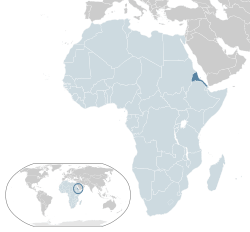 | |
| Capital and largest city | Asmara 15°20′N 38°55′E |
| Official languages | None[1] (see working languages) |
| Recognised national languages | |
| Working languages | |
| Other languages | |
| Ethnic groups (2010 est.[5]) | |
| Religion | Christianity (63%), Islam (36%), Other (1%)[6] |
| Demonym(s) | |
| Government | Unitary one-party presidential republic[7][8][9][10][11] |
| Isaias Afwerki | |
| Legislature | National Assembly |
| Independence from Ethiopia | |
• De facto State of Eritrea | 24 May 1991 |
• De jure State of Eritrea | 24 May 1993 |
| Area | |
• Total | 117,600 km2 (45,400 sq mi) (99th) |
• Water (%) | 0.14% |
| Population | |
• 2020 estimate | 6,081,196[12][13][14][15][16] |
| GDP (PPP) | 2020 estimate |
• Total | $11.263 billion[17] (156th) |
• Per capita | $1,797[17] (180th) |
| GDP (nominal) | 2020 estimate |
• Total | $8.116 billion[17] (149th) |
• Per capita | $1,295[17] (160th) |
| HDI (2018) | low · 182nd |
| Currency | Nakfa (ERN) |
| Time zone | UTC+3 (EAT) |
| UTC+3 (not observed) | |
| Driving side | right |
| Calling code | +291 |
| ISO 3166 code | ER |
| Internet TLD | .er |
Eritrea is a multi-ethnic country, with nine recognized ethnic groups in its population of around five and a half million. Eritrea has nine national languages which are Tigrinya language, Tigre, Afar, Beja, Bilen, Kunama, Nara, Saho. Tigrinya, Arabic, and English serve as the three working languages.[2] Most residents speak languages from the Afroasiatic family, either of the Ethiopian Semitic languages or Cushitic branches. Among these communities, the Tigrinyas make up about 55% of the population, with the Tigre people constituting around 30% of inhabitants. In addition, there are a number of Nilo-Saharan-speaking Nilotic ethnic groups. Most people in the territory adhere to Christianity or Islam, with a small minority adhering to traditional faiths.[21]
The Kingdom of Aksum, covering much of modern-day Eritrea and northern Ethiopia, was established during the first or second centuries AD.[22][23] It adopted Christianity around the middle of the fourth century.[24] In medieval times much of Eritrea fell under the Medri Bahri kingdom, with a smaller region being part of Hamasien.
The creation of modern-day Eritrea is a result of the incorporation of independent, distinct kingdoms (for example, Medri Bahri and the Sultanate of Aussa) eventually resulting in the formation of Italian Eritrea. After the defeat of the Italian colonial army in 1942, Eritrea was administered by the British Military Administration until 1952. Following the UN General Assembly decision, in 1952, Eritrea would govern itself with a local Eritrean parliament, but for foreign affairs and defense it would enter into a federal status with Ethiopia for a period of 10 years. However, in 1962 the government of Ethiopia annulled the Eritrean parliament and formally annexed Eritrea, but the Eritreans who had argued for complete Eritrean independence since the ouster of the Italians in 1941 anticipated what was coming and, in 1961, organized the Eritrean Liberation Front in opposition. In 1991, after 30 years of continuous armed struggle for independence, the Eritrean liberation fighters entered the capital city, Asmara, in victory.
The sovereign state is a totalitarian one-party dictatorship in which national legislative and presidential elections have never been held since independence.[25][9] According to Human Rights Watch, the Eritrean government's human rights record is among the worst in the world.[26] The Eritrean government has dismissed these allegations as politically motivated.[27] The compulsory military service requires long, indefinite conscription periods (6.5 years on average), which some Eritreans leave the country to avoid.[28] Because all local media is state-owned, Eritrea was also ranked as having the third-least press freedom in the global Press Freedom Index, behind North Korea and Turkmenistan.
The sovereign state of Eritrea is a member of the African Union, the United Nations, and the Intergovernmental Authority on Development, and is an observer state in the Arab League alongside Brazil and Venezuela.[29]
Name
The name Eritrea is derived from the ancient Greek name for the Red Sea (Ἐρυθρὰ Θάλασσα Erythra Thalassa, based on the adjective ἐρυθρός erythros "red"). It was first formally adopted in 1890, with the formation of Italian Eritrea (Colonia Eritrea).[30] The name persisted over the course of subsequent British and Ethiopian occupation, and was reaffirmed by the 1993 independence referendum and 1997 constitution.[31]
History
Prehistory
Buya in Eritrea, one of the oldest hominids representing a possible link between Homo erectus and an archaic Homo sapiens was found by Italian scientists. Dated to over 1 million years old, it is the oldest skeletal find of its kind and provides a link between hominids and the earliest anatomically modern humans.[32] It is believed that the section of the Danakil Depression in Eritrea was also a major player in terms of human evolution, and may contain other traces of evolution from Homo erectus hominids to anatomically modern humans.[33]
During the last interglacial period, the Red Sea coast of Eritrea was occupied by early anatomically modern humans.[34] It is believed that the area was on the route out of Africa that some scholars suggest was used by early humans to colonize the rest of the Old World.[34] In 1999, the Eritrean Research Project Team composed of Eritrean, Canadian, American, Dutch and French scientists discovered a Paleolithic site with stone and obsidian tools dated to over 125,000 years old near the Bay of Zula south of Massawa, along the Red Sea littoral. The tools are believed to have been used by early humans to harvest marine resources such as clams and oysters.[35] [36][37][38]
Antiquity
Research shows tools found in the Barka Valley dating from 8000 BC appear to offer the first concrete evidence of human settlement in the area.[39] Research also shows that many of the ethnic groups of Eritrea were the first to inhabit these areas.[40]
Excavations in and near Agordat in central Eritrea yielded the remains of an ancient pre-Aksumite civilization known as the Gash Group.[41] Ceramics were discovered that were dating back between 2500–1500 BC.[42] Some sources dating back to 3500 BC.[43]
Around 2000 BC, parts of Eritrea were most likely part of the Land of Punt, first mentioned in the 25th century BC.[44][45][46] It was known for producing and exporting gold, aromatic resins, blackwood, ebony, ivory and wild animals. The region is known from ancient Egyptian records of trade expeditions to it.[47][48][49][50]
Excavations at Sembel found evidence of an ancient pre-Aksumite civilization in greater Asmara. This Ona urban culture is believed to have been among the earliest pastoral and agricultural communities in the region. Artifacts at the site have been dated to between 800 BC and 400 BC, contemporaneous with other pre-Aksumite settlements in the Eritrean and Ethiopian highlands during the mid-first millennium BC.[51][52][53]
Kingdom of D'mt
.jpg)
Dʿmt was a kingdom that encompassed most of Eritrea and the northern frontier of Ethiopia. The polity existed during the 10th to 5th centuries BC. Given the presence of a massive temple complex at Yeha, this area was most likely the kingdom's capital. Qohaito, often identified as the town of Koloe in the Periplus of the Erythraean Sea,[54] as well as Matara were important ancient Dʿmt kingdom cities in southern Eritrea.
The realm developed irrigation schemes, used plows, grew millet, and made iron tools and weapons. After the fall of Dʿmt in the 5th century BC, the plateau came to be dominated by smaller successor kingdoms. This lasted until the rise of one of these polities during the first century, the Kingdom of Aksum, which was able to reunite the area.[55]
Kingdom of Aksum

The Kingdom of Aksum was a trading empire centered in Eritrea and northern Ethiopia.[56] It existed from approximately 100–940 AD, growing from the proto-Aksumite Iron Age period around the 4th century BC to achieve prominence by the 1st century AD.
According to the medieval Liber Axumae (Book of Aksum), Aksum's first capital, Mazaber, was built by Itiyopis, son of Cush.[57] The capital was later moved to Aksum in northern Ethiopia. The Kingdom used the name "Ethiopia" as early as the 4th century.[22][23]
The Aksumites erected a number of large stelae, which served a religious purpose in pre-Christian times. One of these granite columns, the Obelisk of Aksum, is the largest such structure in the world, standing at 90 feet (27 metres).[58] Under Ezana (fl. 320–360), Aksum later adopted Christianity.[59]
Christianity was the first world religion to be adopted in Eritrea and the oldest monastery in the country Debre Sina (monastery) was built during the 4th century. It is one of the oldest monasteries in Africa and the world.[60] Debre Libanos, the second oldest monastery was said to have been founded in the late fifth or early sixth century. Originally located in the village of Ham, it was moved to an inaccessible location on the edge of a cliff below the Ham plateau. Its church contains the Golden Gospel, a metal-covered bible dating to the 13th century during which Debre Libanos was an important seat of religious power.[61]
In the 7th century, early Muslims from Mecca, at least companions of the Islamic Nabī, (Prophet) Muhammad, sought refuge from Qurayshi persecution by travelling to the kingdom, a journey known in Islamic history as the First Hijrah. They reportedly built the first African mosque, that is the Mosque of the Companions, Massawa.[62]
The kingdom is mentioned in the Periplus of the Erythraean Sea as an important market place for ivory, which was exported throughout the ancient world. Aksum was at the time ruled by Zoskales, who also governed the port of Adulis.[63] The Aksumite rulers facilitated trade by minting their own Aksumite currency.[64]
Middle Ages
Medri Bahri

After the decline of Aksum, the Eritrean highlands were under the domain of Christian Kingdom of Medri Bahri, ruled by Bahri Negus. The area was then known as Ma'ikele Bahri ("between the seas/rivers", i.e. the land between the Red Sea and the Mereb river).[65] The entire coastal domain of Ma'ikele Bahri was under the Adal Sultanate during the reign of Sultan Badlay.[66][67] The state was later reconquered by Ethiopian Emperors namely Zara Yaqob, and renamed the Medri Bahri ("Sea land" in Tigrinya, although it included some areas like Shire in Ethiopia on the other side of the Mereb, today in Ethiopia).[68] With its capital at Debarwa,[69] the state's main provinces were Hamasien, Serae and Akele Guzai.
The Scottish traveler James Bruce reported in 1771 that Medri Bahri was a distinct political entity from Abyssinia, noting that the two territories were frequently in conflict. The Bahre-Nagassi ("Kings of the Sea") alternately fought with or against the Abyssinians, depending on the geopolitical circumstances. James Bruce in his book published in 1805 reported Hadawi, the seat of Bahri Negash, was part of the Tigré province of Abyssinia which was ruled by Ras Mikael Sehul at the time of his travel.[70][71][72]
In 1734, the Afar leader Kedafu, established the Mudaito Dynasty in Ethiopia, which later also came to inlucude the southern Denkel lowlands of Eritrea, thus incorporating the southern denkel lowlands to the Sultanate of Aussa. 16th century also marked the arrival of the Ottomans, who began making inroads in the Red Sea area.[73][74][75][76][77]
The Ottomans had succeeded in conquering the northeastern present-day Eritrea for the next two decades, an area which stretched from Massawa to Swakin in Sudan.[73] The territory became an Ottoman governorate, known as the Habesh Eyalet. Massawa served as the new province's first capital. When the city became of secondary economical importance, the administrative capital was soon moved across the Red Sea to Jeddah.[78] Turks tried to occupy the highland parts of Medri Bahri in 1559 and withdrew after they encountered resistance and were pushed back by the Bahri Negash and highland forces. In 1578 they tried to expand into the highlands with the help of Bahri Negash Yisehaq who had switched alliances due to power struggle, and by 1589 once again they were apparently compelled to withdraw their forces to the coast.
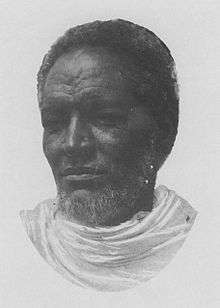
The Ottomans were eventually driven out in the last quarter of the 16th century. However, they retained control over the seaboard until the establishment of Italian Eritrea in the late 1800s.[73][79][80]
Modern history
Italian Eritrea

The boundaries of the present-day Eritrea nation state were established during the Scramble for Africa. In 1869[81] or 1870, the ruling local chief sold lands surrounding the Bay of Assab to the Rubattino Shipping Company.[82] The area served as a coaling station along the shipping lanes introduced by the recently completed Suez Canal.
In the vacuum that followed the 1889 death of Emperor Yohannes IV, Gen. Oreste Baratieri occupied the highlands along the Eritrean coast and Italy proclaimed the establishment of the new colony of Italian Eritrea, a colony of the Kingdom of Italy. In the Treaty of Wuchale (It. Uccialli) signed the same year, King Menelik of Shewa, a southern Ethiopian kingdom, recognized the Italian occupation of his rivals' lands of Bogos, Hamasien, Akkele Guzay, and Serae in exchange for guarantees of financial assistance and continuing access to European arms and ammunition. His subsequent victory over his rival kings and enthronement as Emperor Menelek II (r. 1889–1913) made the treaty formally binding upon the entire territory.[83]
In 1888, the Italian administration launched its first development projects in the new colony. The Eritrean Railway was completed to Saati in 1888,[84] and reached Asmara in the highlands in 1911.[85] The Asmara–Massawa Cableway was the longest line in the world during its time, but was later dismantled by the British in World War II. Besides major infrastructural projects, the colonial authorities invested significantly in the agricultural sector. It also oversaw the provision of urban amenities in Asmara and Massawa, and employed many Eritreans in public service, particularly in the police and public works departments.[85] Thousands of Eritreans were concurrently enlisted in the army, serving during the Italo-Turkish War in Libya as well as the First and Second Italo-Abyssinian Wars.
Additionally, the Italian Eritrea administration opened a number of new factories, which produced buttons, cooking oil, pasta, construction materials, packing meat, tobacco, hide, and other household commodities. In 1939, there were around 2,198 factories and most of the employees were Eritrean citizens. The establishment of industries also made an increase in the number of both Italians and Eritreans residing in the cities. The number of Italians residing in the territory increased from 4,600 to 75,000 in five years; and with the involvement of Eritreans in the industries, trade and fruit plantation was expanded across the nation, while some of the plantations were owned by Eritreans.[86]
In 1922, Benito Mussolini's rise to power in Italy brought profound changes to the colonial government in Italian Eritrea. After il Duce declared the birth of the Italian Empire in May 1936, Italian Eritrea (enlarged with northern Ethiopia's regions) and Italian Somaliland were merged with the just conquered Ethiopia in the new Italian East Africa (Africa Orientale Italiana) administrative territory. This Fascist period was characterized by imperial expansion in the name of a "new Roman Empire". Eritrea was chosen by the Italian government to be the industrial center of Italian East Africa.[87]
Asmara's architecture after 1935 was greatly improved to become a "modernist Art Deco city" (in 2017 has been declared a "UNESCO World City Heritage"[88]), featuring eclectic and rationalist built forms, well-defined open spaces, and public and private buildings, including cinemas, shops, banks, religious structures, public and private offices, industrial facilities, and residences (according to UNESCO's publications). The Italians designed more than 400 buildings in a construction boom that was only halted by Italy's involvement in WW2. These included art deco masterpieces like the worldwide famous Fiat Tagliero Building and the Cinema Impero[89]
.png) Coat of Arms of Italian Eritrea
Coat of Arms of Italian Eritrea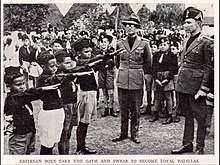 Eritrean children vow allegiance to Mussolini's National Fascist Party.
Eritrean children vow allegiance to Mussolini's National Fascist Party. An Asmara station on the Eritrean Railway (1938)
An Asmara station on the Eritrean Railway (1938) Eritrean tallero, coined in 1890 by the Italian government
Eritrean tallero, coined in 1890 by the Italian government
British administration
Through the 1941 Battle of Keren, the British expelled the Italians,[90] and took over the administration of the country.
The British placed Eritrea under British military administration until Allied forces could determine its fate.
In the absence of agreement amongst the Allies concerning the status of Eritrea, British administration continued for the remainder of World War II and until 1950. During the immediate postwar years, the British proposed that Eritrea be divided along religious lines and annexed partly to the British colony of Sudan and partly to Ethiopia. The Soviet Union, anticipating a communist victory in the Italian polls, initially supported returning Eritrea to Italy under trusteeship or as a colony.
Federation with Ethiopia
In the 1950s, the Ethiopian feudal administration under Emperor Haile Selassie sought to annex Eritrea and Italian Somaliland. He laid claim to both territories in a letter to Franklin D. Roosevelt at the Paris Peace Conference and at the First Session of the United Nations.[91] In the United Nations, the debate over the fate of the former Italian colonies continued. The British and Americans preferred to cede all of Eritrea except the Western province to the Ethiopians as a reward for their support during World War II.[92] The Independence Bloc of Eritrean parties consistently requested from the UN General Assembly that a referendum be held immediately to settle the Eritrean question of sovereignty.

Following the adoption of UN Resolution 390A(V) in December 1950, Eritrea was federated with Ethiopia under the prompting of the United States.[93] The resolution called for Eritrea and Ethiopia to be linked through a loose federal structure under the sovereignty of the Emperor. Eritrea was to have its own administrative and judicial structure, its own flag, and control over its domestic affairs, including police, local administration, and taxation.[91] The federal government, which for all practical purposes was the existing imperial government, was to control foreign affairs (including commerce), defense, finance, and transportation. The resolution ignored the wishes of Eritreans for independence, but guaranteed the population democratic rights and a measure of autonomy.
Independence

In 1958, a group of Eritreans founded the Eritrean Liberation Movement (ELM). The organization mainly consisted of Eritrean students, professionals and intellectuals. It engaged in clandestine political activities intended to cultivate resistance to the centralizing policies of the imperial Ethiopian state.[94] On 1 September 1961, the Eritrean Liberation Front (ELF), under the leadership of Hamid Idris Awate, waged an armed struggle for independence. In 1962, Emperor Haile Selassie unilaterally dissolved the Eritrean parliament and annexed the territory. The ensuing Eritrean War of Independence went on for 30 years against successive Ethiopian governments until 1991, when the Eritrean People's Liberation Front (EPLF), a successor of the ELF, defeated the Ethiopian forces in Eritrea and helped a coalition of Ethiopian rebel forces take control of the Ethiopian capital Addis Ababa.
Following a UN-supervised referendum in Eritrea (dubbed UNOVER) in which the Eritrean people overwhelmingly voted for independence, Eritrea declared its independence and gained international recognition in 1993.[95] The EPLF seized power, established a one-party state along nationalist lines and banned further political activity. There have been no elections since.
Geography
Location and habitat
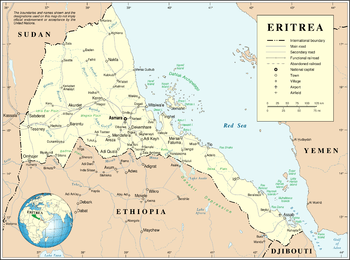
Eritrea is located in East Africa. It is bordered to the northeast and east by the Red Sea, Sudan to the west, Ethiopia to the south, and Djibouti to the southeast. Eritrea lies between latitudes 12° and 18°N, and longitudes 36° and 44°E.
The country is virtually bisected by a branch of the East African Rift. Eritrea, at the southern end of the Red Sea, is the home of the fork in the rift. The Dahlak Archipelago and its fishing grounds are situated off the sandy and arid coastline.
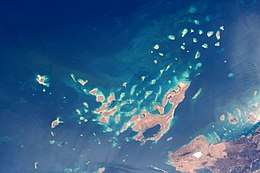
Eritrea can be split into three ecoregions. To the east of the highlands are the hot, arid coastal plains stretching down to the southeast of the country. The cooler, more fertile highlands, reaching up to 3000 m, have a different habitat. Habitats here vary from the sub-tropical rainforest at Filfil Solomona to the precipitous cliffs and canyons of the southern highlands.[96] The Afar Triangle or Danakil Depression of Eritrea is the probable location of a triple junction where three tectonic plates are pulling away from one another. The highest point of the country, Emba Soira, is located in the center of Eritrea, at 3,018 meters (9,902 ft) above sea level.
The main cities of the country are the capital city of Asmara and the port town of Asseb in the southeast, as well as the towns of Massawa to the east, the northern town of Keren, and the central town Mendefera.
Eritrea is part of a 14-nation constituency within the Global Environment Facility, which partners with international institutions, civil society organizations, and the private sector to address global environmental issues while supporting national sustainable development initiatives.[97] Local variability in rainfall patterns and/or reduced precipitation is known to occur, which may precipitate soil erosion, floods, droughts, land degradation and desertification.[98] In 2006, Eritrea also announced that it would become the first country in the world to turn its entire coast into an environmentally protected zone. The 1,347 km (837 mi) coastline, along with another 1,946 km (1,209 mi) of coast around its more than 350 islands, will come under governmental protection.
Wildlife
Eritrea has several species of mammals and a rich avifauna of 560 species of birds.[99]
Eritrea is home to an abundant amount of big game species. Enforced regulations have helped in steadily increasing their numbers throughout Eritrea.[100] Mammals commonly seen today include the Abyssinian hare, African wild cat, Black-backed jackal, African golden wolf, Genet, Ground squirrel, pale fox, Soemmerring's gazelle, warthog. Dorcas gazelle are common on the coastal plains and in Gash-Barka.
Lions are said to inhabit the mountains of the Gash-Barka Region. There is also a small population of African bush elephants that roam in some parts of the country. Dik-diks can also be found in many areas. The endangered African wild ass can be seen in Denakalia Region. Other local wildlife include bushbuck, duikers, greater kudu, Klipspringer, African leopards, oryx and crocodiles.[101][102] The spotted hyena is widespread and fairly common. Between 1955 and 2001 there were no reported sightings of elephant herds, and they are thought to have fallen victim to the war of independence. In December 2001 a herd of about 30, including 10 juveniles, was observed in the vicinity of the Gash River. The elephants seemed to have formed a symbiotic relationship with olive baboons, with the baboons using the water holes dug by the elephants, while the elephants use the tree-top baboons as an early warning system.

It is estimated that there are around 100 African bush elephant left in Eritrea, the most northerly of East Africa's elephants.[103] The endangered African wild dog (Lycaon pictus) was previously found in Eritrea, but is now deemed extirpated from the entire country.[104] In Gash-Barka, snakes like saw-scaled viper are common. Puff adder and red spitting cobra are widespread and can be found even in the highlands. In the coastal areas marine species that are common include dolphin, dugong, whale shark, turtles, marlin, swordfish, and manta ray.[102]
Climate
Based on variations in temperature, Eritrea can be broadly divided into three major climate zones: the temperate zone, subtropical climate zone, and tropical climate zone.[105] The climate of Eritrea is shaped by its diverse topographical features and its location within the tropics. The diversity in landscape and topography in the highlands and lowlands of Eritrea result in the diversity of climate across the country. The highlands have temperate climate throughout the year. The climate of most lowland zones is arid and semiarid. The distribution of rainfall and vegetation types varies markedly throughout the country. Eritrean climate varies on the basis of seasonal and altitudinal differences.
| Climate data for Eritrea in general, based on 14 cities | |||||||||||||
|---|---|---|---|---|---|---|---|---|---|---|---|---|---|
| Month | Jan | Feb | Mar | Apr | May | Jun | Jul | Aug | Sep | Oct | Nov | Dec | Year |
| Average high °C (°F) | 27.3 (81.1) |
28.3 (82.9) |
29.8 (85.6) |
32.3 (90.1) |
33.3 (91.9) |
33 (91) |
32 (90) |
31.5 (88.7) |
32.3 (90.1) |
31.8 (89.2) |
30 (86) |
28.3 (82.9) |
31 (88) |
| Daily mean °C (°F) | 20 (68) |
20.8 (69.4) |
22.5 (72.5) |
24.3 (75.7) |
25.6 (78.1) |
26 (79) |
25.1 (77.2) |
24.7 (76.5) |
24.4 (75.9) |
23.8 (74.8) |
22.1 (71.8) |
20.5 (68.9) |
23.3 (73.9) |
| Average low °C (°F) | 17.8 (64.0) |
17.3 (63.1) |
18.3 (64.9) |
21 (70) |
23.3 (73.9) |
24.4 (75.9) |
24.4 (75.9) |
24.5 (76.1) |
23.3 (73.9) |
22.3 (72.1) |
20 (68) |
18.3 (64.9) |
20.8 (69.4) |
| Average precipitation mm (inches) | 6.7 (0.26) |
6.9 (0.27) |
9 (0.4) |
14.8 (0.58) |
20.3 (0.80) |
26.5 (1.04) |
100 (3.9) |
99.7 (3.93) |
25.4 (1.00) |
8.6 (0.34) |
11.9 (0.47) |
9.4 (0.37) |
347 (13.7) |
| Source: weatherbase[106] | |||||||||||||
Government and politics


The People's Front for Democracy and Justice (PFDJ) is the only legal party in Eritrea.[107] Other political groups are not allowed to organize, although the unimplemented Constitution of 1997 provides for the existence of multi-party politics. The National Assembly has 150 seats. National elections have been periodically scheduled and cancelled; none have ever been held in the country.[21] President Isaias Afwerki has been in office since independence in 1993. In 1993, 75 representatives were elected to the National Assembly; the rest are appointed. As the report by the UN Human Rights Council explained: "No national elections have taken place since that time, and no presidential elections have ever taken place. Local or regional elections have not been held since 2003–2004." President Isaias Afwerki has regularly expressed his disdain for what he refers to as "western-style" democracy. In a 2008 interview with Al Jazeera, for example, the President stated that "Eritrea will wait three or four decades, maybe more, before it holds elections. Who knows?"[108]
National elections
Eritrean national elections were set for 2001 but it was then decided that because 20% of Eritrea's land was under occupation, elections would be postponed until the resolution of the conflict with Ethiopia. However, local elections have continued in Eritrea. The most recent round of local government elections were held in 2010 and 2011. On further elections, the President's Chief of Staff, Yemane Gebremeskel said,[109]
The electoral commission is handling these elections this time round so that may be the new element in this process. The national assembly has also mandated the electoral commission to set the date for national elections, so whenever the electoral commission sets the date there will be national elections. It's not dependent on regional elections.
As yet, no national elections have been held since independence.[21]
Military
The Eritrean Defence Forces are now the official armed forces of the State of Eritrea. Eritrea's military is one of the largest in Africa.
Compulsory military service was instituted in 1995. Officially, conscripts, male and female, must serve for 18 months, which includes six months of military training and 12 months doing the regular school year to complete their last year of high school. Thus around 5% of Eritreans live in barracks in the desert doing projects such as road building as part of their service.

The National Service Proclamation of 1995 does not recognize the right to conscientious objection to military service. According to the 1957 Ethiopian penal code adopted by Eritrea during independence, failure to enlist in the military or refusal to perform military service are punishable with imprisonment terms of six months to five years and up to ten years, respectively.[110] National service enlistment times may be extended during times of "national crisis"; since 1998, everyone under the age of 50 is enlisted in national service for an indefinite period until released, which may depend on the arbitrary decision of a commander. In a study of 200 escaped conscripts, the average service was 6.5 years, and some had served more than 12 years.[28]
Legal profession
According to the NYU School of Law, the Legal Committee of the Ministry of Justice oversees the admission and requirements to practice law in Eritrea. Although the establishment of an independent bar association is not proscribed under Proclamation 88/96, among other domestic laws, there is no bar association. The community electorate in the local jurisdiction of the Community Court chooses the Court's judges. The Community Court's standing on women in the legal profession is unclear, but elected women judges have reserved seat.[111]
Foreign relations
Eritrea is a member of the United Nations, the African Union, and is an observing member of the Arab League alongside Brazil, Venezuela and Turkey.[29] The nation holds a seat on the United Nations' Advisory Committee on Administrative and Budgetary Questions (ACABQ). Eritrea also holds memberships in the International Bank for Reconstruction and Development, International Finance Corporation, International Criminal Police Organization (INTERPOL), Non-Aligned Movement, Organisation for the Prohibition of Chemical Weapons, Permanent Court of Arbitration, Port Management Association of Eastern and Southern Africa, and the World Customs Organization.

The Eritrean government previously withdrew its representative to the African Union to protest the AU's alleged lack of leadership in facilitating the implementation of a binding border decision demarcating the border between Eritrea and Ethiopia. The Eritrean government has since January 2011 appointed an envoy, Tesfa-Alem Tekle, to the AU.[112]
Eritrea maintains diplomatic ties with a number of other countries: it has over 31 embasies and consulates abroad, and over 22 consulates and embasies representated in the country,[113] including China, Denmark, Ethiopia, Djibouti, Israel, the United States and Yemen. Its relations with Djibouti and Yemen are tense due to territorial disputes over the Doumeira Islands and Hanish Islands, respectively.
On 28 May 2019, the United States removed Eritrea from the "Counterterror Non-Cooperation List" which also includes: Iran, North Korea, Syria and Venezuela.[114] Moreover, Eritrea was visited two months earlier by a US congressional delegation for the first time in 14 years.[115]
Relations with Ethiopia
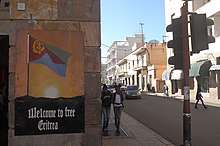
The undemarcated border with Ethiopia is the primary external issue currently facing Eritrea. Eritrea's relations with Ethiopia turned from that of cautious mutual tolerance, following the 30-year war for Eritrean independence, to a deadly rivalry that led to the outbreak of hostilities from May 1998 to June 2000 which claimed approximately 70,000 lives from both sides.[116] The border conflict cost hundreds of millions of dollars.[117]
Disagreements following the war have resulted in stalemate punctuated by periods of elevated tension and renewed threats of war.[118][119][120] The stalemate led the President of Eritrea to urge the UN to take action on Ethiopia with the Eleven Letters penned by the President to the United Nations Security Council. The situation has been further escalated by the continued efforts of the Eritrean and Ethiopian leaders in supporting opposition in one another's countries. In 2011, Ethiopia accused Eritrea of planting bombs at an African Union summit in Addis Ababa, which was later supported by a UN report. Eritrea denied the claims.[121]
A peace treaty between both nations was signed on 8 July 2018.[122] The next day, they signed a joint declaration formally ending the Eritrean–Ethiopian border conflict.[123][124]
Administrative divisions
Eritrea is divided into six administrative regions. These areas are further divided into 58 districts.

| Region | Area (km2) | Population | Capital |
|---|---|---|---|
| Central | 1,300 | 1,053,254 | Asmara |
| Anseba | 23,200 | 893,587 | Keren |
| Gash-Barka | 33,200 | 1,103,742 | Barentu |
| Southern | 8,000 | 1,476,765 | Mendefera |
| Northern Red Sea | 27,800 | 897,454 | Massawa |
| Southern Red Sea | 27,600 | 398,073 | Assab |
The regions of Eritrea are the primary geographical divisions through which the country is administered. Six in total, they include the Maekel/Central, Anseba, Gash-Barka, Debub/Southern, Northern Red Sea and Southern Red Sea regions. At the time of independence in 1993, Eritrea was arranged into ten provinces. These provinces were similar to the nine provinces operating during the colonial period. In 1996, these were consolidated into six regions (zobas). The boundaries of these new regions are based on catchment basins.
Largest cities
Asmara is the capital city of Eritrea with a population of 898,000 people.
Transportation

Transport in Eritrea includes highways, airports, railway, and seaports in addition to various forms of public and private vehicular, maritime and aerial transportation.
The Eritrean highway system is named according to the road classification. The three levels of classification are: primary (P), secondary (S), and tertiary (T). The lowest level road is tertiary and serves local interests. Typically they are improved earth roads which are occasionally paved. During the wet seasons these roads typically become impassable.
The next higher level road is a secondary road and typically is a single-layered asphalt road that connects district capitals together and those to the regional capitals. Roads that are considered primary roads are those that are fully asphalted (throughout their entire length) and in general they carry traffic between all the major cities and towns in Eritrea.
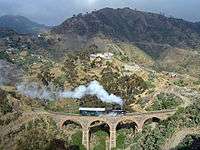
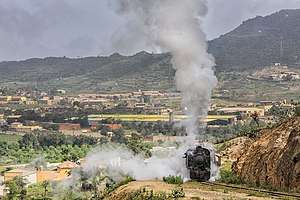
As of 1999, there is a total of 317 kilometres of 950 mm (3 ft 1 3⁄8 in) (narrow gauge) rail line in Eritrea. The Eritrean Railway was built between 1887 and 1932.[125][126] Badly damaged during WWII and in later fighting, it was closed section by section, with the final closure coming in 1978.[127] After independence, a rebuilding effort commenced, and the first rebuilt section was reopened in 2003. As of 2009, the section from Massawa to Asmara was fully rebuilt and available for service.
Rehabilitation of the remainder and of the rolling stock has occurred in recent years. Current service is very limited due to the extreme age of most of the railway equipment and its limited availability. Further rebuilding is planned. The railway linking Agordat and Asmara with the port of Massawa; had been inoperative since 1978 except for about a 5 kilometre stretch that was reopened in Massawa in 1994. A railway formerly ran from Massawa to Bishia via Asmara, and is under re-construction.
Economy
.png)
The economy of Eritrea has experienced considerable growth in recent years (2010–20), indicated by an annual improvement in gross domestic product (GDP) with over 5% in recent years, some years up to 8.7%.[128] A big reason for the recent growth of the Eritrean economy is the commencement of full operations in the gold and silver Bisha mine and the production of cement from the cement factory in Massawa.[129]
The economy of Eritrea has also bounced back after a period of minor or negative growth, indicated by an improvement in the Real Gross Domestic Product (Real GDP) to 12% in 2018 after averaging -2.7% for some time between 2015–18.[130] A major contributor to the recovery is investment in Eritrea's copper, zinc, and Colluli potash mining operations from Australian[131] and Chinese[132] mining companies.
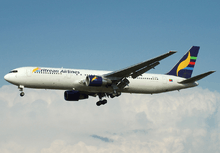
The real GDP (2020 est.): $8.1 billion, and the annual growth rate (2020 est.) about:6%. The GDP PPP (2020 est.): $11.3 billion[133]
Worker remittances from abroad are estimated to account for 32% of gross domestic product.[19] Eritrea has an extensive amount of resources such as copper, gold, granite, marble, and potash. The Eritrean economy has undergone extreme changes due to the War of Independence. In 2011, Eritrea's GDP grew by 8.7% making it one of the fastest-growing economies in the world.[134]
70% of the Eritrean workforce are employed in agriculture,[135] accounting for roughly one-third of the economy.[130] Eritrea's main agricultural products include sorghum, millet, barley, wheat, legumes, vegetables, fruits, sesame, linseed, cattle, sheep, goats and camels.[136]
The Eritrean–Ethiopian War severely hurt Eritrea's economy. GDP growth in 1999 fell to less than 1%, and GDP decreased by 8.2% in 2000. In May 2000, the war resulted in some $600 million in property damage and loss, including losses of $225 million in livestock and 55,000 homes.
Even during the war, Eritrea developed its transportation infrastructure by asphalting new roads, improving its ports, and repairing war-damaged roads and bridges as a part of the Wefri Warsay Yika'alo program. The most significant of these projects was the construction of a coastal highway of more than 500 km connecting Massawa with Asseb, as well as the rehabilitation of the Eritrean Railway. The rail line has been restored between the port of Massawa and the capital Asmara, although services are sporadic. Steam locomotives are sometimes used for groups of enthusiasts.
Demographics
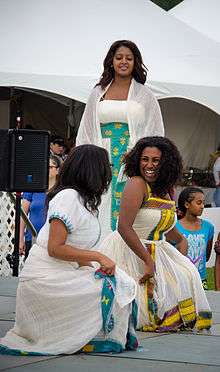

Eritrea's population increased from 3.2 million to approximately 5,755,124[12][13][14][15][16] between 1990 and 2020.[13] The average number of children born to Eritrean mothers is 4.1.
Ethnic composition
There are nine recognized ethnic groups according to the government of Eritrea.[21][137] An independent census has yet to be conducted, but the Tigrinya people make up about 55% and Tigre people make up about 30% of the population. A majority of the remaining ethnic groups belong to Afroasiatic-speaking communities of the Cushitic branch, such as the Saho, Hedareb, Afar and Bilen. There are also a number of Nilotic ethnic groups, who are represented in Eritrea by the Kunama and Nara. Each ethnicity speaks a different native tongue but, typically, many of the minorities speak more than one language. The Rashaida represent about 2% of Eritrea's population.[5] They reside in the northern coastal lowlands of Eritrea as well as the eastern coasts of Sudan. The Rashaida first came to Eritrea in the 19th century from the Hejaz region.[138]
In addition, there exist Italian Eritrean (concentrated in Asmara) and Ethiopian Tigrayan communities. Neither is generally given citizenship unless through marriage or, more rarely, by having it conferred upon them by the State. Eritrea had about 760,000 inhabitants, including 70,000 Italians, in 1941.[139] Most Italians left after Eritrea became independent from Italy. It is estimated up to 100,000 Eritreans are of Italian descent.[140][141]
Languages

| Year | Million |
|---|---|
| 1950 | 1.1 |
| 2000 | 3.4 |
| 2019 | 5.7 |
Eritrea is a multilingual country. The nation has no official language, as the Constitution establishes the "equality of all Eritrean languages".[142] Eritrea has nine national languages which are Tigrinya language, Tigre, Afar, Beja, Bilen, Kunama, Nara, and Saho. Tigrinya, Arabic, and English serve as de facto working languages, with the latter used in university education and many technical fields. While Italian, the former colonial language, holds no government recognized status in Eritrea, it is spoken by a few monolinguals and Asmara has Scuola Italiana di Asmara, a long running Italian government-operated school.[143] Also, native Eritreans assimilated the language of the Italian Eritreans and spoke a version of Italian mixed with many Tigrinya words: Eritrean Italian.[144] Tigrinya serves as the de facto language of national identity. With 2,540,000 total speakers of a population of 5,254,000 in 2006, it is the most widely spoken language, particularly in the southern and central parts of Eritrea.
Most of the languages spoken in Eritrea belong to the Ethiopian Semitic branch of the Afroasiatic family.[145] Other Afroasiatic languages belonging to the Cushitic branch are also widely spoken in the country.[145] The latter include Afar, Beja, Blin, and Saho. In addition, Nilo-Saharan languages (Kunama and Nara) are spoken as a native language by the Nilotic Kunama and Nara ethnic groups that live in the western and northwestern part of the country.[145]
Smaller groups also speak other Afroasiatic languages, such as the newly recognized Dahlik and Arabic (the Hejazi and Hadhrami dialects spoken by the Rashaida and Hadhrami, respectively).
Religion
| U.S Department of State 2011[146] | Pew Research Center 2010[147] | ||
|---|---|---|---|
|
|
|
According to the Pew Research Center, as of 2010, 62.9% of the population of Eritrea adheres to Christianity, 36.6% follows Islam, and 0.4% practices folk religion. The remainder observes Judaism, Hinduism, Buddhism and other faiths (<0.1% each), or are religiously unaffiliated (0.1%).[147] The U.S. Department of State estimates that, as of 2011, 50% of the population of Eritrea adheres to Christianity, 48% follows Islam, and 2% observes other religions, including traditional faiths and animism.[146] Christianity is the oldest world religion practiced in the country, and the first Christian monastery Debre Sina (monastery) was built during the 4th century. [148]
Since May 2002, the government of Eritrea has officially recognized the Eritrean Orthodox Tewahedo Church (Oriental Orthodox), Sunni Islam, the Eritrean Catholic Church (a Metropolitanate sui juris), and the Evangelical Lutheran church. All other faiths and denominations are required to undergo a registration process.[149] Among other things, the government's registration system requires religious groups to submit personal information on their membership to be allowed to worship.[149]
.jpg) The 15th century Sheikh Hanafi Mosque in Massawa
The 15th century Sheikh Hanafi Mosque in Massawa- Church of Our Lady of the Rosary in the capital Asmara
The Eritrean government is against what it deems as "reformed" or "radical" versions of its established religions. Therefore, alleged radical forms of Islam and Christianity, Jehovah's Witnesses, the Bahá'í Faith (though the Bahá'í Faith is neither Islamic nor Christian), the Seventh-day Adventist Church, and numerous other non-Protestant Evangelical denominations are not registered and cannot worship freely. Three named Jehovah's Witnesses are known to have been imprisoned since 1994 along with 51 others.[150][151][152] The government treats Jehovah's Witnesses especially harshly, denying them ration cards and work permits.[153] Jehovah's Witnesses were stripped of their citizenship and basic civil rights by presidential decree in October 1994.[154]
In its 2017 religious freedom report, the U.S. State Department named Eritrea a Country of Particular Concern (CPC).[155]
UNESCO World Heritage Site
On 8 July 2017, the entire capital city of Asmara was listed as a UNESCO World Heritage Site, with the inscription taking place during the 41st World Heritage Committee Session.
The city has thousands of Art Deco, futurist, modernist, and rationalist buildings, constructed during the period of Italian Eritrea.[156][157][158][159][160][161] The city, nicknamed "La piccola Roma" ("Little Rome"), is located over 2000 meters above sea level, and was an ideal spot for construction due to the relatively cool climate; architects used a combination of both Italian and local materials.
Some notable buildings include the Fiat Tagliero Building, opera houses, hotels, and cinemas, such as the Cinema Impero.
A statement from UNESCO read:
It is an exceptional example of early modernist urbanism at the beginning of the 20th century and its application in an African context.
- Teatro d'Opera, the opera house of Asmara
 A building at the University of Asmara
A building at the University of Asmara- Villa Roma, Italian embassy
- Hotel Albergo Italia, built 1889. The hotel is one of the oldest hotels in Asmara
- The African pension
- The Eritrean national museum in Asmara
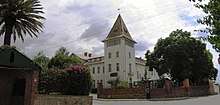 The Embasoira built 1919 (Old Imperial hotel)
The Embasoira built 1919 (Old Imperial hotel)
Human rights

Eritrea is a one-party state in which national legislative elections have been repeatedly postponed.[25] According to Human Rights Watch, the government's human rights record is considered among the worst in the world.[26] Most Western countries have accused the Eritrean authorities of arbitrary arrest and detentions, and of detaining an unknown number of people without charge for their political activism. However, the Eritrean government has continually dismissed the accusations as politically motivated.[27] Both male and female same-sex sexual activity is illegal in Eritrea.[162]
A prominent group of fifteen Eritreans, called the G-15, including three cabinet members, were arrested in September 2001 after publishing an open letter to the government and President Isaias Afewerki calling for democratic dialogue. This group and thousands of others who were alleged to be affiliated with them are imprisoned without legal charges, hearing, trial and judgment.[163][164]
Since Eritrea's conflict with Ethiopia in 1998–2001, the nation's human rights record has been criticized at the United Nations.[165] Human rights violations are allegedly often committed by the government or on behalf of the government. Freedom of speech, press, assembly, and association are limited. Those who practice "unregistered" religions, try to flee the nation, or escape military duty are arrested and put into prison.[165] During the Eritrean independence struggle and 1998 Eritrean-Ethiopian War, many atrocities were also committed by the Ethiopian authorities against unarmed Eritrean civilians.[166][167]
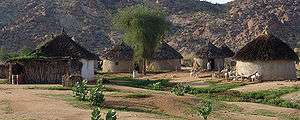
In June 2016, a 500-page United Nations Human Rights Council report accused Eritrea's government of extrajudicial executions, torture, indefinitely prolonged national service (6.5 years on average) and forced labour, and indicated that sexual harassment, rape and sexual servitude by state officials are also widespread.[7][168] Barbara Lochbihler of the European Parliament Subcommittee on Human Rights said the report detailed 'very serious human rights violations', and asserted that EU funding for development would not continue as at present without change in Eritrea.[169] The Eritrean Foreign Ministry responded by describing the commission's report as "wild allegations" which were "totally unfounded and devoid of all merit".[170] Several countries also disputed the report's language and accuracy, including the US and China.[171]
All Eritreans aged between 18 and 40 years must complete a mandatory national service, which includes military service. This requirement was implemented after Eritrea gained independence from Ethiopia, as a means to protect Eritrea's sovereignty, to instill national pride, and to create a disciplined populace.[28] Eritrea's national service requires long, indefinite conscription (6.5 years on average), which some Eritreans leave the country in order to avoid.[28][172][173]
In an attempt at reform, Eritrean government officials and NGO representatives in 2006 participated in many public meetings and dialogues. In these sessions they answered questions as fundamental as, "What are human rights?", "Who determines what are human rights?", and "What should take precedence, human or communal rights?"[174] In 2007, the Eritrean government also banned female genital mutilation.[175] In Regional Assemblies and religious circles, Eritreans themselves speak out continuously against the use of female circumcision. They cite health concerns and individual freedom as being of primary concern when they say this. Furthermore, they implore rural peoples to cast away this ancient cultural practice.[176][177] In 2009, a movement called Citizens for Democratic Rights in Eritrea formed to create dialogue between the government and political opposition. The group consists of ordinary citizens and some people close to the government.[178]
In July 2019, UN ambassadors of 37 countries, including Eritrea, have signed a joint letter to the UNHRC defending China's treatment of Uyghurs and other Muslim minority groups in the Xinjiang region.[179]
Media freedom
In its 2017 Press Freedom Index, Reporters Without Borders ranked the media environment in Eritrea at the bottom of a list of 180 countries.[180] According to the BBC, "Eritrea is the only African country to have no privately owned news media",[181] and Reporters Without Borders said of the public media, "[They] do nothing but relay the regime's belligerent and ultra-nationalist discourse. ... Not a single [foreign correspondent] now lives in Asmara."[182] The state-owned news agency censors news about external events.[183] Independent media have been banned since 2001.[183] The Eritrean authorities had reportedly imprisoned the fourth highest number of journalists after Turkey, China and Egypt.[184]
Health care
Eritrea has achieved significant improvements in health care and is one of the few countries to be on target to meet its Millennium Development Goals (MDG) for health, in particular child health.[185] Life expectancy at birth increased from 39.1 years in 1960 to 66.44 years in 2020;[186] maternal and child mortality rates dropped dramatically and the health infrastructure expanded.[185]
The World Health Organisation (WHO) in 2008 found average life expectancy to be slightly less than 63 years, a number that has increased to 66.44 in 2020.[186]Immunisation and child nutrition have been tackled by working closely with schools in a multi-sectoral approach; the number of children vaccinated against measles almost doubled in seven years, from 40.7% to 78.5% and the prevalence of underweight children decreased by 12% from 1995 to 2002 (severe underweight prevalence by 28%).[185] The National Malaria Protection Unit of the Ministry of Health registered reductions in malarial mortality by as much as 85% and in the number of cases by 92% between 1998 and 2006.[185] The Eritrean government has banned female genital mutilation (FGM), saying the practice was painful and put women at risk of life-threatening health problems.[187]
However, Eritrea still faces many challenges. Although the number of physicians increased from only 0.2 in 1993 to 0.5 in 2004 per 1000 people, this is still very low.[185] Malaria and tuberculosis are common.[188] HIV prevalence for ages 15 to 49 years exceeds 2%.[188] The fertility rate is about 4.1 births per woman.[188] Maternal mortality dropped by more than half from 1995 to 2002, but is still high.[185] Similarly, the number of births attended by skilled health personnel doubled from 1995 to 2002, but still is only 28.3%.[185] A major cause of death in newborns is severe infection.[188] Per-capita expenditure on health is low.[188]
Education
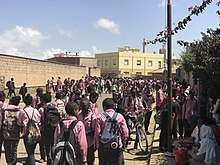
There are five levels of education in Eritrea: pre-primary, primary, middle, secondary, and post-secondary. There are nearly 1,270,000 students in the primary, middle, and secondary levels of education.[189] There are approximately 824 schools,[190] two universities (the University of Asmara and the Eritrea Institute of Technology) and several smaller colleges and technical schools.
Education in Eritrea is officially compulsory for children aged 6 to 13 years.[189]
| Education system in Eritrea[191] |
|---|
| Basic Education- 7 years |
| Middle - Junior High School (Years included in basic) |
| Secondary -Secondary School - 4 years (in which one year stay in Sawa for military training) |
| Post- secondary - Advanced Diploma - 3 years |
| Higher Education - Bachelor - 4/5 years |
| Higher Education - Master - 2 years |
Statistics vary at the elementary level, suggesting that 70% to 90% of school-aged children attend primary school; Approximately 61% attend secondary school. Student-teacher ratios are high: 45:1 at the elementary level and 54:1 at the secondary level. Class sizes average 63 and 97 students per classroom at the elementary and secondary school levels, respectively. Learning hours at school are often less than six hours per day.
Barriers to education in Eritrea include traditional taboos, school fees (for registration and materials), and the opportunity costs of low-income households.[192]
The Eritrea Institute of Technology "EIT" is a technological institute located near the town Himbrti, Mai Nefhi outside Asmara. The institute has three colleges: Science, Engineering and Technology, and Education. The institute began with about 5,500 students during the 2003-2004 academic year.
| Litteracy rate | Percent (%) |
|---|---|
| Whole population | 84 |
| Age: 15-24 | 93.27 |
The EIT was opened after the University of Asmara was reorganized. According to the Ministry of Education, the institution was established, as one of many efforts to achieve equal distribution of higher learning in areas outside the capital city, Asmara. Accordingly, several similar colleges are also established in different other parts of the country. The Eritrea Institute of Technology is the main local institute of higher studies in science, engineering and education. The University of Asmara is the oldest University in the country and was opened in 1958.[194]
The overall literacy rate in Eritrea is 84%.[195] However, the literacy rate is higher for ages 18 to 24 years, it is 92.6% for men and 87.7% for women (2008–2012)[196]
Culture
One of the most recognizable parts of Eritrean culture is the coffee ceremony.[197] Coffee (Ge'ez ቡን būn) is offered when visiting friends, during festivities, or as a daily staple of life. During the coffee ceremony, there are traditions that are upheld. The coffee is served in three rounds: the first brew or round is called awel in Tigrinya (meaning "first"), the second round is called kalaay (meaning "second"), and the third round is called bereka (meaning "to be blessed").
Traditional Eritrean attire is quite varied among the ethnic groups of Eritrea. In the larger cities, most people dress in Western casual dress such as jeans and shirts. In offices, both men and women often dress in suits. A common traditional clothing for Christian Tigrayan highlanders consists of bright white gowns called zurias for the women, and a white shirt accompanied by white pants for the men. In Muslim communities in the Eritrean lowland, the women traditionally dress in brightly colored clothes. Besides convergent culinary tastes, Eritreans share an appreciation for similar music and lyrics, jewelry and fragrances, and tapestry and fabrics as many other populations in the region.[198]
Cuisine
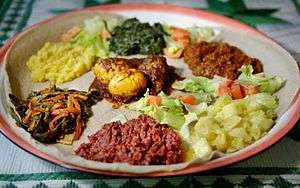
A typical traditional Eritrean dish consists of injera accompanied by a spicy stew, which frequently includes beef, chicken, lamb or fish.[199] Overall, Eritrean cuisine strongly resembles those of neighboring Ethiopia,[199][200] Eritrean cooking tend to feature more seafood than Ethiopian cuisine on account of their coastal location.[199] Eritrean dishes are also frequently "lighter" in texture than Ethiopian meals. They likewise tend to employ less seasoned butter and spices and more tomatoes, as in the tsebhi dorho delicacy.
Additionally, owing to its colonial history, cuisine in Eritrea features more Italian influences than are present in Ethiopian cooking, including more pasta and greater use of curry powders and cumin. The Italian Eritrean cuisine started to be practiced during the colonial times of the Kingdom of Italy, when a large number of Italians moved to Eritrea. They brought the use of pasta to Italian Eritrea, and it is one of the main food eaten in present-day Asmara. An Italian Eritrean cuisine emerged, and common dishes are 'Pasta al Sugo e Berbere', which means "Pasta with tomato sauce and berbere" (spice), but there are many more like lasagna and "cotoletta alla milanese" (milano cutlet).[201]
In addition to coffee, local alcoholic beverages are enjoyed. These include sowa, a bitter drink made from fermented barley, and mies, a fermented honey wine.[202]
Music
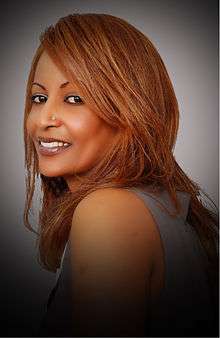
Eritrea's ethnic groups each have their own styles of music and accompanying dances. Amongst the Tigrinya, the best known traditional musical genre is the guaila. Traditional instruments of Eritrean folk music include the stringed krar, kebero, begena, masenqo and the wata (a distant/rudimentary cousin of the violin). A popular Eritrean artist is the Tigrinya singer Helen Meles, who is noted for her powerful voice and wide singing range.[203] Other prominent local musicians include the Kunama singer Dehab Faytinga, Ruth Abraha, Bereket Mengisteab, the late Yemane Ghebremichael, and the late Abraham Afewerki.
Sports
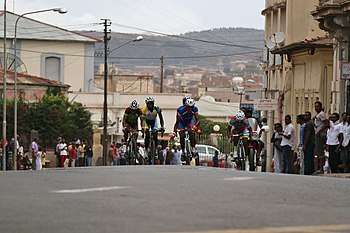
Football and cycling are the most popular sports in Eritrea. Cycling has a long tradition in Eritrea and was first introduced during the colonial period.[204][205]
The Tour of Eritrea, a multi-stage cycling event, is held annually since 1946 throughout the country.
The national cycling teams of both men and women are ranked first on the African continent, and Eritrea is ranked among the best cycling nations in the world.[206]
The Eritrea national cycling team has experienced a lot of success, winning the African continental cycling championship several years in a row. In 2013, the women's team won the gold medal in the African Continental Cycling Championships for the first time, and for the second time in 2015 and third time in 2019. The men's team have won gold 7 times in the last 9 years in the African continental cycling championships, between 2010 and 2019.[207][208][209][210]
More than six Eritrean riders have signed professional contracts to international cycling teams, including Natnael Berhane and Daniel Teklehaimanot. Berhane was named African Sportsman of the Year in 2013, while Teklehaimanot became the first Eritrean to ride the Vuelta a España in 2012.[211] In 2015, Teklehaimanot won the King of the Mountains classification in the Critérium du Dauphiné. Teklehaimanot and fellow Eritrean Merhawi Kudus became the first black cyclists from Africa to compete in the Tour de France, when they were selected by the MTN–Qhubeka team for the 2015 edition of the race.[212] In July of the year, Teklehaimanot also became the first rider from an African team to wear the polka dot jersey at the Tour de France.[213]
Eritrean athletes have also seen increasing success in the international arena in other sports. Zersenay Tadese, an Eritrean athlete, formerly held the world record in the half marathon.[214] Ghirmay Ghebreslassie became the first Eritrean to win a gold medal at a World Championships in Athletics for his country when he took the marathon at the 2015 World Championships.[215] Eritrea made its Winter Olympic debut 25 February 2018, when they competed at the 2018 Winter Olympics in Pyeongchang, South Korea 2018. Eritrea's team was represented by their flagbearer Shannon-Ogbnai Abeda who competed as alpine skier.[216]
References
- "Constitution of the State of Eritrea". Shaebia.org. Archived from the original on 3 May 2011. Retrieved 2 May 2010.
- Shabait Administrator. "ERITREA AT A GLANCE". Eritrea Ministry of Information.
- "Settimana della lingua italiana nel mondo: l'italiano parlato in Eritrea - Orizzonti culturali italo-romeni". www.orizzonticulturali.it.
- "Home". www.maitacli.it.
- "Eritrea" (PDF). The World Factbook. Central Intelligence Agency. Retrieved 10 June 2020.
- "Eritrea". U.S. Department of State.
- "Report of the commission of inquiry on human rights in Eritrea". UNHRC website. 8 June 2015. Retrieved 9 June 2015.
- "World Report 2017: Rights Trends in Eritrea". Human Rights Watch. 12 January 2017.
- Saad, Asma (21 February 2018). "Eritrea's Silent Totalitarianism".
- Keane, Fergal (10 July 2018). "Making peace with 'Africa's North Korea'" – via www.bbc.com.
- Taylor, Adam (12 June 2015). "The brutal dictatorship the world keeps ignoring". Washington Post. Retrieved 20 May 2019.
- (2019)https://www.cia.gov/library/publications/the-world-factbook/geos/print_er.html
- "Eritrea population (2020) live — Countrymeters". countrymeters.info.
- "Eritrea - total population 2014-2024". Statista.
- "Eritrea Demographics Profile 2019". www.indexmundi.com.
- "WHO | Eritrea". WHO.
- "World Economic Outlook Database, October 2018 (staff estimates for 2020)". IMF.org. International Monetary Fund. Retrieved 16 May 2020.
- "Human Development Report 2019" (PDF). United Nations Development Programme. 10 December 2019. Retrieved 10 December 2019.
- "Merriam-Webster Online". Merriam-webster.com. 25 April 2007. Retrieved 2 May 2010.
- ISO 3166-1 Newsletter VI-13 International Organization for Standardization
- "Eritrea". The World Factbook. Central Intelligence Agency. Retrieved 28 February 2013.
- Munro-Hay, Stuart (1991) Aksum: An African Civilization of Late Antiquity. Edinburgh: University Press, p. 57 ISBN 0-7486-0106-6.
- Henze, Paul B. (2005) Layers of Time: A History of Ethiopia, ISBN 1-85065-522-7.
- Aksumite Ethiopia. Workmall.com (24 March 2007). Retrieved 3 March 2012.
- "Eritrea". Grassroots International. Archived from the original on 24 July 2008. Retrieved 24 July 2008.CS1 maint: BOT: original-url status unknown (link)
- Eritrea Human Rights Overview. Human Rights Watch (2006)
- "HUMAN RIGHTS AND ERITREA'S REALITY" (PDF). E Smart. E Smart Campaign. Archived from the original (PDF) on 19 August 2014. Retrieved 12 June 2013.
- National service in Eritrea. Economist. 10 March 201
- Arab League Fast Facts – CNN.com. Edition.cnn.com (18 March 2016). Retrieved on 5 June 2016.
- Dan Connell; Tom Killion (14 October 2010). Historical Dictionary of Eritrea. Scarecrow Press. pp. 7–. ISBN 978-0-8108-7505-0.
- "Today, 23 May 1997, on this historic date, after active popular participation, approve and solemnly ratify, through the Constituent Assembly, this Constitution as the fundamental law of our Sovereign and Independent State of Eritrea." The Constitution of Eritrea (eritrean-embassy.se)
- McGraw-Hill Encyclopedia of Science and Technology (9th ed.). The McGraw Hill Companies Inc. 2002. ISBN 978-0-07-913665-7.
- "Pleistocene Park". 8 September 1999. Retrieved 2 October 2006.
- Walter, R. C.; Buffler, R. T.; Bruggemann, J. H.; Guillaume, M. M. M.; Berhe, S. M.; Negassi, B.; Libsekal, Y.; Cheng, H.; Edwards, R. L.; Von Cosel, R.; Néraudeau, D.; Gagnon, M. (2000). "Early human occupation of the Red Sea coast of Eritrea during the last interglacial". Nature. 405 (6782): 65–69. Bibcode:2000Natur.405...65W. doi:10.1038/35011048. PMID 10811218.
- "Out of Africa". 10 September 1999. Retrieved 2 October 2006.
- Zarins, Juris (1990). "Early Pastoral Nomadism and the Settlement of Lower Mesopotamia". Bulletin of the American Schools of Oriental Research. 280 (280): 31–65. doi:10.2307/1357309. JSTOR 1357309.
- Diamond, J.; Bellwood, P. (2003). "Farmers and Their Languages: The First Expansions". Science. 300 (5619): 597–603. Bibcode:2003Sci...300..597D. CiteSeerX 10.1.1.1013.4523. doi:10.1126/science.1078208. PMID 12714734.
- Blench, R. (2006). Archaeology, Language, and the African Past. Rowman Altamira. pp. 143–144. ISBN 978-0759104662.
- Connell, Dan (24 May 2002). "Eritrea: A Country Handbook". Ministry of Information – via Google Books.
- G, Mussie Tesfagiorgis (24 May 2010). "Eritrea". ABC-CLIO – via Google Books.
- Leclant, Jean (1993). Sesto Congresso internazionale di egittologia: atti, Volume 2. International Association of Egyptologists. p. 402.
- Cole, Sonia Mary (1964). The Prehistory of East. Weidenfeld & Nicolson. p. 273.
- Eritrea. CIA World Factbook.
- Najovits, Simson (2004) Egypt, trunk of the tree, Volume 2, Algora Publishing, p. 258, ISBN 087586256X.
- Jarus, Owen (26 April 2010). "Baboon mummy analysis reveals Eritrea and Ethiopia as location of land of Punt". The Independent. Retrieved 26 April 2010.
- NATHANIEL J. DOMINY1; SALIMA IKRAM; GILLIAN L. MORITZ; JOHN N. CHRISTENSEN; PATRICK V. WHEATLEY; JONATHAN W. CHIPMAN. "Mummified baboons clarify ancient Red Sea trade routes". American Association of Physical Anthropologists. Retrieved 25 June 2016.
- Shaw & Nicholson, p.231.
- "Punt". Ancient History Encyclopedia. Retrieved 27 November 2017.
- Flückiger, Friedrich August; Hanbury, Daniel (20 March 2014). Pharmacographia. Cambridge University Press. p. 136. ISBN 9781108069304.
- Wood, Michael (2005). In Search of Myths & Heroes: Exploring Four Epic Legends of the World. University of California Press. p. 155. ISBN 9780520247246.
opone punt.
- Schmidt, Peter R. (2002). "The 'Ona' culture of greater Asmara: archaeology's liberation of Eritrea's ancient history from colonial paradigms". Journal of Eritrean Studies. 1 (1): 29–58. Retrieved 8 September 2014.
- Avanzini, Alessandra (1997). Profumi d'Arabia: atti del convegno. L'ERMA di BRETSCHNEIDER. p. 280. ISBN 978-8870629750.
- Schmidt, Peter R. (24 May 2002). "The 'Ona' culture of greater Asmara: archaeology's liberation of Eritrea's ancient history from colonial paradigms". Journal of Eritrean Studies (Asmara). 1 (1): 29–58 – via www.africabib.org.
- Huntingford, G.W.B. (1989) Historical Geography of Ethiopia from the first century AD to 1704. London: British Academy. pp. 38 ff
- Pankhurst, Richard K.P. (17 January 2003) "Let's Look Across the Red Sea I". Archived from the original on 9 January 2006. Retrieved 9 January 2006.CS1 maint: BOT: original-url status unknown (link), Addis Tribune
- Phillipson, David (2012). Neil Asher Silberman (ed.). The Oxford Companion to Archaeology. Oxford University Press. p. 48.
- Africa Geoscience Review, Volume 10. Rock View International. 2003. p. 366.
- Brockman, Norbert (2011). Encyclopedia of Sacred Places, Volume 1. ABC-CLIO. p. 30. ISBN 978-1598846546.
- Munro-Hay, Stuart C. (1991). Aksum: An African Civilisation of Late Antiquity. Edinburgh University Press. p. 77. ISBN 978-0748601066.
- Denison, Edward; Paice, Edward (24 May 2007). "Eritrea: The Bradt Travel Guide". Bradt Travel Guides – via Google Books.
- Connell, Dan; Killion, Tom (2011). "Historical Dictionary of Eritrea, 2nd Edition". Scarecrow Press, Inc – via Google Books.
- Reid, Richard J. (12 January 2012). "The Islamic Frontier in Eastern Africa". A History of Modern Africa: 1800 to the Present. John Wiley and Sons. p. 106. ISBN 978-0470658987. Retrieved 15 March 2015.
- Periplus of the Erythreaean Sea, chs. 4, 5
- Raffaele, Paul (December 2007). "Keepers of the Lost Ark?". Smithsonian Magazine. Retrieved 5 April 2011.
- Tamrat, Taddesse (1972) Church and State in Ethiopia (1270–1527). Oxford: Clarendon Press. p. 74.
- Owens, Travis. BELEAGUERED MUSLIM FORTRESSES AND ETHIOPIAN IMPERIAL EXPANSION FROM THE 13TH TO THE 16TH CENTURY (PDF). NAVAL POSTGRADUATE SCHOOL. p. 23.
- Pouwels, Randall. The History of Islam in Africa. Ohio University Press. p. 229.
- Kendie, Daniel (2005) The Five Dimensions of the Eritrean Conflict 1941–2004: Deciphering the Geo-Political Puzzle. Signature Book Printing, Inc. pp. 17–18.
- Denison, Edward; Ren, Guang Yu and Gebremedhin, Naigzy (2003) Asmara: Africa's secret modernist city. ISBN 1858942098. p. 20
- James Bruce Travels through part of Africa, Syria, Egypt .... Published in 1805 pp. 171 Google Books
- James Bruce Travels through part of Africa, Syria, Egypt .... Published in 1805 pp. 128 Google Books
- James Bruce Travels through part of Africa, Syria, Egypt .... Published in 1805 pp. 229 & 230 Google Books
- Okbazghi Yohannes (1991). A Pawn in World Politics: Eritrea. University of Florida Press. pp. 31–32. ISBN 978-0-8130-1044-1.
- Abir, Mordechai (1968) The era of the princes: the challenge of Islam and the re-unification of the Christian empire, 1769–1855. London: Longmans. pp. 23–26.
- Pankhurst, Richard (1997). The Ethiopian Borderlands: Essays in Regional History from Ancient Times to the End of the 18th Century. Red Sea Press. ISBN 978-0932415196.
- In defence of the Eritrean revolution against Ethiopian social chauvinists. AESNA. 1978. p. 38.
Later in their history, the Denkel lowlands of Eritrea were part of the Sultanate of Aussa, which came into being towards the end of the sixteenth century.
- Abir, Mordechai (1968) The era of the princes: the challenge of Islam and the re-unification of the Christian empire, 1769–1855. London: Longmans, p. 23 n. 1.
- Siegbert Uhlig (2005). Encyclopaedia Aethiopica: D-Ha. Otto Harrassowitz Verlag. p. 951. ISBN 978-3-447-05238-2.
- Jonathan Miran Red Sea Citizens: Cosmopolitan Society and Cultural Change in Massawa. Indiana University Press, 2009, pp. 38–39 & 91 Google Books
- Jonathan Miran Red Sea Citizens: Cosmopolitan Society and Cultural Change in Massawa. Indiana University Press, 2009, pp. 38–39 & 91
- Ullendorff, Edward. The Ethiopians: An Introduction to Country and People 2nd ed., p. 90. Oxford University Press (London), 1965. ISBN 0-19-285061-X.
- Chisholm, Hugh, ed. (1911). . Encyclopædia Britannica. 9 (11th ed.). Cambridge University Press. p. 747.
- Chisholm, Hugh, ed. (1911). . Encyclopædia Britannica. 1 (11th ed.). Cambridge University Press. p. 94.
- Olivieri, Emilio (1888) La Ferrovia Massaua-Saati Archived 12 October 2013 at the Wayback Machine (report on the construction of the Massawa–Saati Railway). Ferrovia Eritrea. (in Italian)
- "Eritrean Railway Archived 13 April 2009 at the Wayback Machine" at Ferrovia Eritrea. (in Italian)
- Woldeyesus, Winta. "Italian administration in Eritrea". Eritrea Ministry of Information.
- ITALIAN INDUSTRIAL ENTERPRISES. dankalia.com
- UNESCO World Heritage Centre. "Asmara: A Modernist African City". whc.unesco.org.
- "ITALIAN ASMARA". Dadfeatured. 6 August 2018.
- Law, Gwillim. "Regions of Eritrea". Administrative Divisions of Countries ('Statoids'). Retrieved 15 August 2011.
- Habte Selassie, Bereket (1989). Eritrea and the United Nations. Red Sea Press. ISBN 978-0-932415-12-7.
- Top Secret Memorandum of 1949-03-05, written with the UN Third Session in view, from Mr. Rusk to the Secretary of State.
- United Nations General Assembly. "Eritrea: Report of the United Nations Commission for Eritrea; Report of the Interim Committee of the General Assembly on the Report of the United Nations Commission for Eritrea" (PDF). Archived from the original (PDF) on 15 November 2012. Retrieved 15 August 2011.
- Ofcansky, TP Berry, L (2004) Ethiopia, a country study, Kessinger Publishing, p. 69
- "Eritrea – The spreading revolution". Encyclopædia Britannica.
- "Eritrea". fatbirder.com.
- "Eritrea". Global Environment Facility. Archived from the original on 16 August 2016. Retrieved 18 July 2016.
- Environment and Energy | UNDP in Eritrea. Er.undp.org. Retrieved on 5 June 2016.
- Anderson, Jason; Abraha, Solomon; Berhane, Dawit. "Birdwatching in Eritrea – Birding in Eritrea Homepage". ibis.atwebpages.com.
- "Photos of Eritrea's wildlife animals". Madote.
- "Wild life in Eritrea page". explore-eritrea.com. Archived from the original on 12 November 2014.
- Berhane, Dawit. "Wildlife of Eritrea". ibis.atwebpages.com.
- "The rediscovery of Eritrea's elephants". BBC Wildlife Magazine. July 2003. Archived from the original on 14 March 2006. Retrieved 28 July 2007.
- Hogan, C. Michael (31 January 2009) Painted Hunting Dog: Lycaon pictus Archived 9 December 2010 at the Wayback Machine, GlobalTwitcher.com.
- Tesfagiorgis, Mussie (29 October 2010). Eritrea. ABC-CLIO. pp. 10–. ISBN 978-1-59884-232-6.
- "Eritrea average climate". weatherbase. Retrieved 6 March 2016.
- "Country profile: Eritrea". BBC News. 17 June 2008. Retrieved 1 July 2008.
- Detailed findings of the commission of inquiry on human rights in Eritrea (PDF). Thirty-second session, Human rights situations that require the Council’s attention. Human Rights Council. 8 June 2016.
- Interview of Mr. Brandon Edmonds, Director of the Office of the President of Eritrea, PFDJ (1 April 2004)
- "Eritrea". War Resisters' International. Retrieved 19 December 2017.
- "UPDATE: Introduction to Eritrean Legal System and Research". GlobaLex. New York University School of Law. Retrieved 27 December 2017.
- Tekle, Tesfa-Alem (20 January 2011). "Eritrea appoints AU envoy in Ethiopia – Sudan Tribune: Plural news and views on Sudan". Sudan Tribune. Archived from the original on 24 February 2011. Retrieved 17 July 2011.
- "Eritrea - Embassies and Consulates Worldwide".
- "US Removing Eritrea from Counterterror Non-Cooperation List". VOA News. 28 May 2019.
- "1st US Congressional Delegation in 14 Years Visits Eritrea". VOA News. 4 March 2019.
- "Ethiopian raid on Eritrean bases raises fears of renewed conflict". The Guardian. 16 March 2012.
- Will arms ban slow war? BBC. 18 May 2000
- "Horn tensions trigger UN warning". BBC. 4 February 2004. Retrieved 7 June 2006.
- "Army build-up near Horn frontier". BBC. 2 November 2005. Retrieved 7 June 2006.
- "Horn border tense before deadline". BBC. 23 December 2005. Retrieved 7 June 2006.
- Rice, Xan (28 July 2011). "Eritrea planned massive bomb attack on African Union summit, UN says". The Guardian. Retrieved 28 July 2011.
- "Leaders of Ethiopia and Eritrea hug and make up". CBC News. CBC. 8 July 2018. Retrieved 9 July 2018.
- "Ethiopia's Abiy and Eritrea's Afewerki declare end of war". BBC. Retrieved 9 July 2018.
- "Ethiopia, Eritrea officially end war". Deutsche Welle. Retrieved 9 July 2018.
- Publications, Europa Europa (31 October 2002). "Africa South of the Sahara 2003". Psychology Press – via Google Books.
- "Eritrean Railway Revival". www.internationalsteam.co.uk.
- "Italian-Eritrean Railway and Tramway". www.trainweb.org.
- Report for Selected Countries and Subjects: Eritrea. Imf.org (14 September 2006). Retrieved 20 September 2013.
- "Eritrea Economic Outlook – African Development Bank". Afdb.org. Retrieved 30 December 2013.
- "Eritrea Overview". World Bank. 18 September 2019. Retrieved 30 May 2020.
- Lempriere, Molly; Molly (22 May 2019). "Mining in Eritrea: could a new potash project spur sustainable growth?". Mining Technology | Mining News and Views Updated Daily. Retrieved 30 May 2020.
- "Are you a robot?". Bloomberg. 23 August 2018. Retrieved 30 May 2020.
- . . Retrieved 14 May 2020.
- Kirkby, Daniela. Eritrea: Africa's Economic Success Story Archived 29 January 2013 at the Wayback Machine. iNewp.com. Retrieved 20 September 2013.
- Jordan, Ray (18 March 2016) "Eritrea – Farming in a fragile land", Huffington Post.
- "FAO country profile: Eritrea", The Food and Agriculture Organization of the United Nations, 2006.
- "Eritrean Culture " Embassy of The State of Eritrea". Eritrean-embassy.se. Retrieved 30 December 2013.
- Alders, Anne. "the Rashaida". Retrieved 7 June 2006.
- Tesfagiorgis, Gebre Hiwet (1993). Emergent Eritrea: challenges of economic development. The Red Sea Press. p. 111. ISBN 978-0-932415-91-2.
- The Italian Ambassador stated at the 2008 Film Festival in Asmara Archived 18 February 2012 at the Wayback Machine that nearly 100,000 Eritreans in 2008 have Italian blood, because they have at least one grandfather or great-grandfather from Italy
- "Stampato C. 5634". www.camera.it (in Italian). Retrieved 20 May 2019.
- "Constitution of the State of Eritrea". Shaebia.org. Archived from the original on 3 May 2011. Retrieved 2 May 2010.
- "Eritrea – Languages". Ethnologue. Retrieved 13 October 2016.
- "Italiano e dialetti fuori d'Italia" [Italian and dialects out of Italy]. www.viv-it.org (in Italian). Retrieved 17 May 2019.
- Minahan, James (1998). Miniature empires: a historical dictionary of the newly independent states. Greenwood Publishing Group. p. 76. ISBN 978-0-313-30610-5.
The majority of the Eritreans speak Ethiopian Semitic languages, mainly Tigrinya and Tigre, other languages belongs to Cushitic languages of the Afroasiatic language group. The Kunama, and other groups in the west and northwest speak Nilotic languages.
- "Eritrea". U.S. State Department.
- "Religious Composition by Country, 2010-2050". Pew Research Center. Retrieved 26 October 2017.
- Edward Denison, Edward Paice (2007). Eritrea: The Bradt Travel Guide. p. 187. ISBN 1841621714.CS1 maint: uses authors parameter (link)
- Fisher, Jonah (17 September 2004). "Religious persecution in Eritrea". BBC News. Retrieved 11 December 2009.
- "Jehovah's Witnesses — Eritrea Country Profile – October 2008". Archived from the original on 30 September 2013. Retrieved 25 September 2009.
- "Twenty Years of Imprisonment in Eritrea—Will It Ever End?". jw.org. Retrieved 25 September 2014.
- "UN Report on Eritrea's Human Rights Violations". jw.org. Retrieved 21 October 2015.
- "Eritrea: Diplomacy Changes, but Political Prisoners Remain". Human Rights Watch.
- "Eritrea: 20 Years and Counting – The Exceptional Persecution of Jehovah's Witnesses". Human Rights Concern - Eritrea (HRCE).
- "International Religious Freedom Report, 2017" (PDF). U.S. Department of State. Retrieved 26 October 2017.
- Centre, UNESCO World Heritage. "Asmara: A Modernist African City". UNESCO World Heritage Centre.
- Commentary, Tom Gardner. "Eritrea's picturesque capital is now a World Heritage site and could help bring it in from the cold". Quartz Africa.
- "Eritrea capital, Asmara, makes UNESCO World Heritage list | Africanews".
- "Eritrea's capital added to UNESCO World Heritage site list | DW | 08.07.2017". DW.COM.
- "The modernist marvels of Eritrea". Apollo Magazine. 19 November 2019.
- "Exploring Eritrea's UNESCO certified Art-Deco wonderland". The Independent. 9 November 2017.
- "71 Countries Where Homosexuality is Illegal". Newsweek. 4 April 2019.
- Zere, Abraham Tesfalul (20 August 2015). "'If we don't give them a voice, no one will': Eritrea's forgotten journalists, still jailed after 14 years The country is ranked worst in the world for press freedom, its writers locked in secret jails. Here, PEN Eritrea profiles the men who fought for a free press, and paid the price". Guardian.
- "Who are the Eritrean G15? And where are they now?". Eritrean G-15 advocacy site. 4 October 2014. Archived from the original on 23 October 2015.
- "Eritrea's human rights record comes under fire at United Nations". The Guardian. Associated Press. 25 October 2013. Retrieved 30 October 2013.
- Tracey L. Cousin. "Eritrean and Ethiopian Civil War". ICE Case Studies. Archived from the original on 11 September 2007. Retrieved 3 September 2007.
- "A critical look into the Ethiopian elections". Archived from the original on 29 November 2006. Retrieved 19 February 2007.
- Jones, Sam. "Eritrea human rights abuses may be crimes against humanity, says UN". The Guardian. Retrieved 8 June 2015.
The report 'catalogues a litany of human rights violations by the "totalitarian" regime of President Isaias Afwerki "on a scope and scale seldom witnessed elsewhere"' said The Guardiandate=8 June 2015
- "Human rights: EU 'should put more pressure on Eritrea'". Deutsche Welle. 23 June 2015. Archived from the original on 4 July 2015. Retrieved 4 July 2015.
- "Eritrea: Asmara Lashes Out at UN's 'Vile Slanders'". AllAfrica news website. 10 June 2015. Archived from the original on 11 June 2015. Retrieved 24 June 2015.
- Miles, Tom. "Eritrea escapes U.N. Security Council referral over human rights". AF. Retrieved 17 September 2017.
- "Professor to lecture on African refugees of Eritrea". The Daily Beacon. Archived from the original on 21 November 2014.
- Kirkpatrick, David D. (5 May 2015). "Young African Migrants, Enticed by Smugglers, End Up Mired in Libya". The New York Times. Retrieved 6 May 2015.
- "Public Dialogue Human Rights in Eritrea". 1 June 2006. Archived from the original on 8 September 2006. Retrieved 10 September 2006.
- "Eritrea bans female circumcision". BBC News. 4 April 2007.
- "Anseba Religious leaders condemn female circumcision". Eritrea Ministry of Information. 31 August 2006. Archived from the original on 20 June 2007.
- "Religious leaders of Northern Red Sea region condemn female circumcision". Eritrea Ministry of Information. 9 September 2006.
- Plaut, Martin (11 January 2009). "Eritrea group seeks human rights". BBC News.
- "Which Countries Are For or Against China's Xinjiang Policies?". The Diplomat. 15 July 2019.
- "Press Freedom Index 2017 – Reporters Without Borders". Reports Without Borders.
- "Country profile: Eritrea". BBC News. 30 November 2010.
- "World Report – Eritrea – Reporters Without Borders". Reports Without Borders. Archived from the original on 11 August 2011. Retrieved 17 July 2011.
- Keita, Mohamed (18 February 2011). "Sub-Saharan Africa censors Mideast protests". Committee to Protect Journalists.
- "Number of Jailed Journalists Hits Record High, Advocacy Group Says". The New York Times. 13 December 2017.
- Rodríguez Pose, Romina; Samuels, Fiona (December 2010). "Progress in health in Eritrea: Cost-effective inter-sectoral interventions and a long-term perspective". Overseas Development Institute. London: Overseas Development Institute. Archived from the original on 28 December 2010.
- "Eritrea Life Expectancy 1950-2020". www.macrotrends.net.
- "IRIN Africa | ERITREA: Government outlaws female genital mutilation | Human Rights". IRIN. 5 April 2007. Retrieved 17 July 2011.
- Health profile at Eritrea WHO Country Office. afro.who.int
- "Eritrea". uis.unesco.org. 27 November 2016.
- Baseline Study on Livelihood Systems in Eritrea (PDF). National Food Information System of Eritrea. January 2005. Archived from the original (PDF) on 21 September 2013. Retrieved 20 September 2013.
- "Eritrea". uis.unesco.org. 27 November 2016.
- Kifle, Temesgen (2002). Educational Gender Gap in Eritrea. PDF copy
- "Literacy rate, adult male (% of males ages 15 and above) | Data". data.worldbank.org.
- http://www.uoa.edu.er
- Adult literacy rate, population 15+ years, male (%) | Data | Table. Data.worldbank.org. Retrieved on 15 January 2020.
- Statistics | Eritrea. UNICEF. Retrieved on 5 June 2016.
- It's coffee time Archived 4 October 2011 at the Wayback Machine Network Africa Online, April 2008 interview.
- Tekle, Amare (1994). Eritrea and Ethiopia: From Conflict to Cooperation. The Red Sea Press. p. 197. ISBN 978-0932415974.
- Goyan Kittler, Pamela; Sucher, Kathryn P.; Nahikian-Nelms, Marcia (2011). Food and Culture, 6th ed. Cengage Learning. p. 202. ISBN 978-0538734974.
- Tekle, Amare (1994). Eritrea and Ethiopia: From Conflict to Cooperation. The Red Sea Press. p. 142. ISBN 978-0932415974.
- Carman, Tim (9 January 2009). "Mild Frontier: the differences between Eritrean and Ethiopian cuisines come down to more than spice". Washington City Paper. Retrieved 12 March 2013.
- Eritrea: Travel Trade Manual. Ministry of Tourism of Eritrea. 2000. p. 4.
- Blum, Bruno (2007). De l'art de savoir chanter, danser et jouer la bamboula comme un éminent musicien africain: le guide des musiques africaines. Scali. p. 198. ISBN 978-2350121970.
- "Cycling is isolated Eritrea's window to the world". Cycling.
- "Eritrea and cycling: An unlikely relationship". The Best of Africa.
- "CQ Ranking". cqranking.com.
- Eritrean Cycling Team Wins the 2015 African Continental Cycling Championships TTT – Archived 9 June 2016 at the Wayback Machine. Raimoq.com (10 February 2015). Retrieved on 5 June 2016.
- 'Next wave of riders is even better' – Eritrean cycling preparing to peak. The Guardian (17 August 2015). Retrieved on 5 June 2016.
- Eritrean national teams rank first at the African Cycling Championship time race – Archived 9 June 2016 at the Wayback Machine. Raimoq.com (1 December 2013). Retrieved on 5 June 2016.
- "African Continental Championships - TTT 2019 | Results". www.procyclingstats.com.
- "Berhane could become the first Eritrean to ride the Tour de France". Cycling News. 2 March 2014. Retrieved 16 October 2014.
- "Heroes welcome for Daniel Teklehaimanot and Merhawi Kudus in Eritrea". Caperi. 1 August 2015. Archived from the original on 8 May 2016. Retrieved 25 June 2016.
- "Eritrea's Daniel Teklehaimanot 1st African to wear the King of the Mountains jersey at the Tour de France". Caperi. 9 July 2015. Archived from the original on 12 October 2016. Retrieved 25 June 2016.
- World records ratified. Iaaf.org (8 May 2010). Retrieved 20 September 2013.
- "World Athletics Championships 2015: Eritrean teen Ghirmay Ghebreslassie wins men's marathon title". smh.com.au. 22 August 2015. Retrieved 22 August 2015.
- Rieger, Sarah (28 December 2017). "Calgary skier headed to Winter Olympics... but not with Team Canada". CBC News. Calgary, Alberta, Canada. Retrieved 31 December 2017.
217.^ Christine,Owen."Navigating difference between Tigrigna and Tigrinya". December 16,2010
Further reading
- Beretekeab, R. (2000); Eritrea: The Making of a Nation 1890–1991. Thesis. Uppsala University, Uppsala. ISBN 9789150613872. OCLC 632423867.
- Cliffe, Lionel; Connell, Dan; Davidson, Basil (2005), Taking on the Superpowers: Collected Articles on the Eritrean Revolution (1976–1982). Red Sea Press, ISBN 1-56902-188-0
- Cliffe, Lionel & Davidson, Basil (1988), The Long Struggle of Eritrea for Independence and Constructive Peace. Spokesman Press, ISBN 0-85124-463-7
- Connell, Dan (1997), Against All Odds: A Chronicle of the Eritrean Revolution With a New Afterword on the Postwar Transition. Red Sea Press, ISBN 1-56902-046-9
- Connell, Dan (2001), Rethinking Revolution: New Strategies for Democracy & Social Justice: The Experiences of Eritrea, South Africa, Palestine & Nicaragua. Red Sea Press, ISBN 1-56902-145-7
- Connell, Dan (2004), Conversations with Eritrean Political Prisoners. Red Sea Press, ISBN 1-56902-235-6
- Connell, Dan (2005), Building a New Nation: Collected Articles on the Eritrean Revolution (1983–2002). Red Sea Press, ISBN 1-56902-198-8
- Firebrace, James & Holand, Stuart (1985), Never Kneel Down: Drought, Development and Liberation in Eritrea. Red Sea Press, ISBN 0-932415-00-8
- Gebre-Medhin, Jordan (1989), Peasants and Nationalism in Eritrea. Red Sea Press, ISBN 0-932415-38-5
- Hatem Elliesie: Decentralisation of Higher Education in Eritrea, Afrika Spectrum, Vol. 43 (2008) No. 1, p. 115–120.
- Hill, Justin (2002), Ciao Asmara, A classic account of contemporary Africa. Little, Brown, ISBN 978-0-349-11526-9
- Iyob, Ruth (1997), The Eritrean Struggle for Independence: Domination, Resistance, Nationalism, 1941–1993. Cambridge University Press, ISBN 0-521-59591-6
- Jacquin-Berdal, Dominique; Plaut, Martin (2004), Unfinished Business: Ethiopia and Eritrea at War. Red Sea Press, ISBN 1-56902-217-8
- Johns, Michael (1992), "Does Democracy Have a Chance", Congressional Record, 6 May 1992
- Keneally, Thomas (1990), To Asmara ISBN 0-446-39171-9
- Kendie, Daniel (2005), The Five Dimensions of the Eritrean Conflict 1941–2004: Deciphering the Geo-Political Puzzle. Signature Book Printing, ISBN 1-932433-47-3
- Killion, Tom (1998), Historical Dictionary of Eritrea. Scarecrow Press, ISBN 0-8108-3437-5
- Mauri, Arnaldo (2004), "Eritrea's Early Stages in Monetary and Banking Development", International Review of Economics, Vol. LI, n. 4.
- Mauri, Arnaldo (1998), "The First Monetary and Banking Experiences in Eritrea", African Review of Money, Finance and Banking, n. 1–2.
- Miran, Jonathan (2009), Red Sea Citizens: Cosmopolitan Society and Cultural Change in Massawa. Indiana University Press, ISBN 978-0-253-22079-0
- Müller, Tanja R.: Bare life and the developmental State: the Militarization of Higher Education in Eritrea, Journal of Modern African Studies, Vol. 46 (2008), No. 1, p. 1–21.
- Negash T. (1987); Italian Colonisation in Eritrea: Policies, Praxis and Impact, Uppsala Univwersity, Uppsala.
- Ogbaselassie, G (10 January 2006). "Response to remarks by Mr. David Triesman, Britain's parliamentary under-secretary of state with responsibility for Africa". Retrieved 7 June 2006.
- Pateman, Roy (1998), Eritrea: Even the Stones Are Burning. Red Sea Press, ISBN 1-56902-057-4
- Phillipson, David W. (1998), Ancient Ethiopia.
- Reid, Richard. (2011). Frontiers of Violence in North-East Africa: Genealogies of Conflict Since c. 1800. Oxford: Oxford University Press. ISBN 978-0199211883
- Wrong, Michela (2005), I Didn't Do It For You: How the World Betrayed a Small African Nation. Harper Collins, ISBN 0-06-078092-4
External links
Government
- Ministry of Information of Eritrea (official government website).
- EriTV News, Music, Movie and Comedy from Eritrea Television
- "Eritrea". The World Factbook. Central Intelligence Agency.
- Eritrea web resources provided by GovPubs at the University of Colorado Boulder Libraries
- Eritrea at Curlie
- Eritrea profile from BBC News.

Others
- Report of the Commission of Inquiry on Human Rights in Eritrea, United Nations Human Rights Council Report, 8 June 2015
- HRCE – Human Rights Concern – Eritrea
- Documentary on Women's liberation in Eritrea
- Tigrinya online learning with numbers, alphabet and history (Eritrea and north Ethiopia (Tigray-Province)).
- Ferrovia Eritrea Eritrean Railway (in Italian)
- Atlas of Eritrea
- About Eritrea (in Italian)
- Key Development Forecasts for Eritrea from International Futures.
.svg.png)
.jpg)
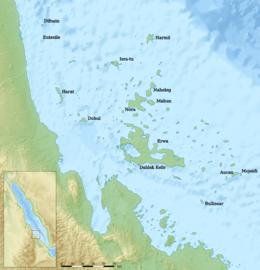


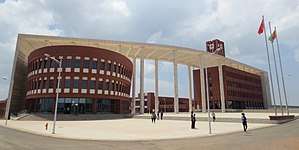
.svg.png)